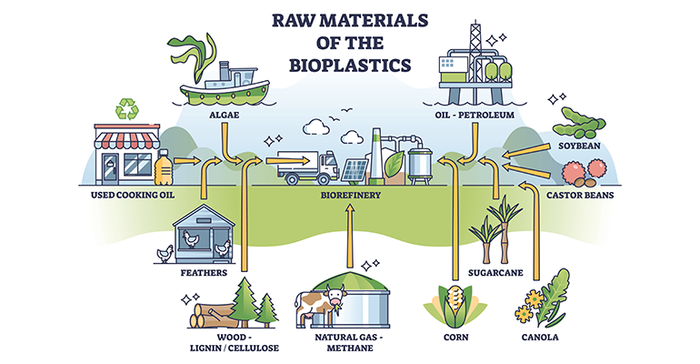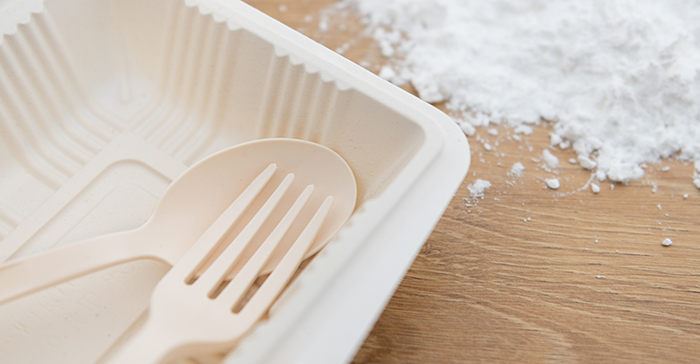The emergence of seaweed packaging can almost be seen as sweet vengeance by the ocean, for the suffering it has endured at the hands of plastic pollution. But although this victim-to-victor story has a lovely ring to it, the likelihood of seaweed - or any other bioplastic for that matter - usurping petroleum derived plastic packaging is currently not that high.
“Plastic is such a versatile, cheap and tried and tested material that other alternatives will always struggle from a cost and performance point of view,” says Paul Jenkins, founder of packaging innovation consultancy ThePackHub.
However, Jenkins says he has observed an increasing amount of development work in the area of seaweed packaging.
“This year alone, we have probably seen 15 to 20 examples of seaweed packaging being tested. This suggests that there is a market appetite for this material and that solutions are being refined for eventual market introduction,” he says.
An embryonic industry
Greentech startups and university spin-offs are spearheading the development of seaweed packaging.
In Norway, B’ZEOS is using minimally processed seaweed extracts to develop home-compostable packaging. After securing funding from Innovation Norway to develop an edible straw in 2017, the startup pivoted to developing flexible packaging solutions, and has since produced flexible films, paper coatings and thermoformables. It has an ongoing collaboration with Nestlé and has recently been granted its first EU grant, PlastiSea.
UK based startup Notpla (short for Not Plastic) has been busy securing investment for its seaweed packaging, and at the end of 2021, raised £10m Series A funding. It gave 36,000 of its edible, biodegradable “Oohos” – bubble-shaped liquid carriers – filled with Lucozade to runners at the 2019 London Marathon. The Notpla takeaway box has also entered the market in collaboration with Just Eat in the UK and is now in use at hundreds of restaurants.
Another greentech company, Zerocircle, is sourcing both edible and non-edible seaweed from farming communities in India to produce transparent, heat sealable, food-safe, home compostable packaging film.
The holy grail?
So how does seaweed packaging stack up as a sustainable alternative to plastic?
Katie Roselaar, founder of sustainable packaging consultancy Innovate to Zero, says that on the face of it, seaweed packaging sounds like the holy grail, as “it starts from nature and returns to nature”, and that a big point in its favour is that it is home compostable.

“When considering sustainable packaging options, the distinction between home compostable and industrial compostable is an important one to make. The popularity of industrial compostable materials is dropping off as there is no easy recycling route,” she says.
Seaweed’s home compostable credentials are great for the planet, but do they affect functionality?
“The problem is that the very characteristics that make a material home compostable, such as the ability to break down when exposed to water, oxygen, heat etc, are the opposite of what food companies need from a performance perspective,” says Roselaar.
‘Pretty poor’ protective barrier properties
OTR (Oxygen Transmission Rate) and WVTR (Water Vapour Transmission Rate) are universal measures for testing the barrier properties of food packaging materials.
“These barrier properties are pretty poor in terms of preserving ambient foods that require a barrier unfortunately. For comparison, a recyclable PE with an EVOH barrier would have a barrier of about 5 or below on OTR and WVTR given the units used. Conventional home compostable materials can also achieve a much better barrier than the seaweed packaging,” says Roselaar.
In real terms she says this means it would be difficult to protect moisture sensitive products such as crisps, nuts, and snacks for any length of time.
“This said, there are many non-food applications or shorter shelf life applications that the material could be very suitable for. Every application would require testing,” she adds.
Limited applications
B'ZEOS openly admits that applications for its seaweed packaging are currently limited to dry and greasy items.
“At the moment seaweed films have lower barrier properties than petroleum-based plastic, as do most biomaterials already on the market such as thermoplastic starch,” says Kela Feller, the company’s communications & partnerships manager.

Biodegradable plastic spoon, fork and knife made from starch.
On the plus side, however, she says these characteristics can actually extend the shelf life of some food products such as fruit and vegetables, bakery products, and cheese.
Also, B’ZEOS says that with more R&D, seaweed-based packaging has the potential to replace plastic in more applications.
Operationally, compostable materials can be difficult to work with too, resulting in compromised seal integrity or line efficiency, as Roselaar explains.
“From an operational point of view, compostable materials are not always straightforward. They can be difficult to seal properly and the seams sometimes break down when exposed to high temperatures during transportation,” she says.
In this respect, B’ZEOS says its products are “thermosealable and mechanically robust” and that it is currently testing their compatibility with industrial flow wrap machines.
Where seaweed really offers an advantage over other plastics is on its carbon footprint: Life Cycle Assessment tests conducted by the University of Aalborg as part of the PlastiSea EU project showed that B’ZEOS uses less than 3kg of CO2 equivalent during the entirety of the value-chain process, (from cultivation to film production) which it says is already lower than other bioplastics at full production scale.
“This shows very promising potential for the production process, where the target is below 1.5 kg of CO2 equivalent,” says Feller.
Seaweed packaging is still at a very early stage of development, and faces a number of barriers to adoption, including price and reluctance to change.
“It is challenging to find clients who are willing to - essentially - invest in sustainable packaging. The seaweed industry for new materials is in the development stage so the biomass itself and the final product is expensive to produce compared to conventional plastic,” says Feller.
However, B’ZEOS is optimistic that as economies of scale kick in, the overall price of the final product will fall, and investment will follow.
“According to our forecasts, by 2030, we will replace 600,000 tons of plastic, thus resulting in a reduction of 900 million CO2 emissions equivalent per year,” says Feller.







